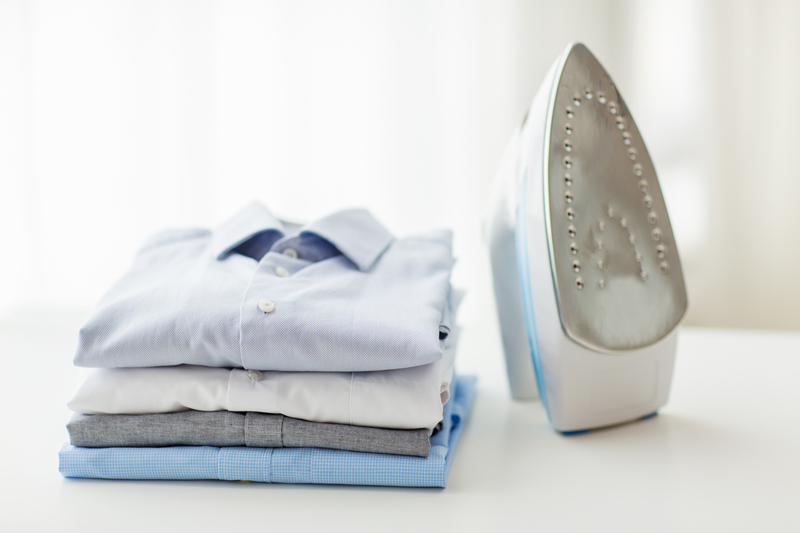Creating Healthier Spaces with Improved Air Quality
Posted on 06/09/2025
Creating Healthier Spaces with Improved Air Quality
Are you aiming to boost your well-being and productivity within your home or workplace? One impactful and often overlooked factor is the quality of the air you breathe every day. Creating healthier spaces with improved air quality not only benefits your respiratory system but enhances your overall health, comfort, and even cognitive performance.
Why Is Indoor Air Quality Important?
Many people spend up to 90% of their time indoors--at home, in the office, or other enclosed environments. Indoor air quality (IAQ) can be 2 to 5 times worse than outdoor air, according to the Environmental Protection Agency (EPA). With the rise of energy-efficient, tightly sealed buildings, fresh air circulation can be limited, allowing pollutants to accumulate.
- Short-term health effects of poor air quality: headaches, fatigue, dizziness, allergy or asthma symptoms.
- Long-term effects include respiratory diseases, heart problems, and even cognitive impairment.
Improving air quality creates environments where people feel better, breathe easier, and thrive, both physically and mentally.

Main Sources of Indoor Air Pollution
To achieve healthier spaces and better air quality, you first need to understand what contributes to indoor pollution. The main sources include:
- Biological pollutants: dust mites, pet dander, mold spores, pollen, and bacteria.
- Chemical pollutants (VOCs): cleaning products, paints, building materials, air fresheners, and tobacco smoke.
- Particulate matter: from cooking, candles, fireplaces, and outdoor air infiltration.
- Gases: such as carbon monoxide (CO), radon, and nitrogen dioxide (NO2).
How to Create Healthier Indoor Spaces with Cleaner Air
Improving indoor air quality involves several critical steps: identifying pollution sources, enhancing ventilation, employing air purification methods, and selecting healthier materials. Let's explore these strategies in detail.
1. Identify and Minimize Pollution Sources
Source control is the most effective way to improve air quality. Start by identifying and removing items or practices that introduce contaminants:
- Avoid tobacco smoking indoors.
- Use low-VOC or VOC-free paints, finishes, and adhesives.
- Store chemicals, paints, and cleaners in sealed containers, away from living areas.
- Promptly address water leaks to prevent mold growth.
- Choose nontoxic, fragrance-free cleaning materials and personal care products.
2. Increase Ventilation and Fresh Air Flow
*Proper ventilation is crucial for maintaining healthy indoor air quality. Regularly exchanging indoor air with fresh outdoor air dilutes pollutants and lowers their concentration.*
- Open windows and doors periodically, especially during and after activities like cooking or cleaning.
- Install exhaust fans in kitchens, bathrooms, and laundry rooms.
- Consider a mechanical ventilation system (such as an HRV or ERV) for tightly sealed modern buildings.
- Use trickle vents or air bricks if possible.
- If outdoor air is highly polluted or during pollen season, use window filters or ventilate during low-pollution times.
3. Maintain Optimal Humidity Levels
Excess humidity encourages the growth of mold, bacteria, and dust mites, while very low humidity can cause respiratory discomfort. Healthy air is achieved with balanced humidity.
- Keep indoor humidity between 30-50%.
- Use dehumidifiers in damp areas, such as basements.
- Repair leaks and address water damage promptly.
- Vent dryers and stoves outdoors when possible.
4. Use High-Quality Air Filtration and Purification Systems
Air filtration is a vital component for improving indoor air quality:
- Upgrade HVAC filters: Choose HEPA or at least MERV-13 rated filters for forced-air systems.
- Room air purifiers: Deploy HEPA-filtered air purifiers in bedrooms and living spaces, especially if you live near busy roads or deal with allergies or asthma.
- Consider activated carbon: Filters with activated charcoal remove odors and chemical fumes (VOCs).
Regular maintenance is crucial:
- Change filters as recommended by manufacturers.
- Clean air ducts every few years, particularly if you see visible dust, mold, or pest infestations.
5. Choose Healthy Interior Materials and Furnishings
Many conventional building and furnishing materials emit VOCs and other pollutants. To promote healthier air indoors:
- Opt for solid wood, glass, or metal furnishings over particleboard or MDF, which may off-gas formaldehyde.
- Select natural fiber carpets, rugs, and curtains (such as wool or cotton), which emit fewer chemicals.
- Look for Greenguard, EcoLabel, or low-VOC certifications on products like flooring, paints, glues, and sealants.
- Allow new furniture, carpets, and paints to "off-gas" in a ventilated garage or outdoor area before bringing them indoors.
6. Incorporate Houseplants Strategically
Houseplants can be a beautiful way to slightly improve indoor air. While their direct air-purification impact is limited in modern homes, they can:
- Absorb some VOCs and CO2 (especially varieties like Peace Lily, Snake Plant, or Spider Plant).
- Increase humidity, creating a more comfortable environment.
- Enhance mood and productivity with their visual appeal.
Important: Choose plants that are non-toxic to pets and children, and don't assume they replace air filtration and ventilation.
Technology and Innovations for Cleaner Air
Recent advances have made it easier than ever to monitor and enhance air quality at home and work. Here's what's available for creating healthier environments with advanced air quality solutions:
Smart Air Quality Monitors
- Track levels of particulate matter, VOCs, CO2, humidity, and temperature in real-time.
- Receive alerts when air quality drops, prompting timely action.
Advanced Air Purifiers
- Some new models feature combined HEPA filtration, UV-C light sterilization, and activated carbon for a multi-layered approach.
- Smart purifiers can automatically adjust speed and filtration based on air quality readings.
Hands-Free and Touchless Solutions
- Touchless faucets, hand dryers, and doors minimize germ transfer and keep spaces cleaner.
- Automated cleaning robots can reduce dust buildup and allergen accumulation.
Air Quality Strategies in Specific Settings
Each indoor environment presents unique challenges and requires customized strategies for better air quality and healthier living spaces:
Homes
- Keep entryways clean--consider a "no shoes indoors" policy to limit pollutant tracking.
- Regularly wash bedding, curtains, and other textiles to remove dust and allergens.
- Wash or replace air conditioning filters monthly during heavy use.
- Utilize range hoods when cooking to vent smoke and grease outside.
Offices and Workspaces
- Arrange for frequent cleaning and dusting, ideally with microfibre cloths and non-toxic agents.
- Discourage air fresheners or scented candles which emit VOCs.
- Incorporate live plants and natural light to boost morale and air freshness.
- Monitor carbon dioxide levels to prevent drowsiness and maintain cognitive function.
Schools and Childcare Facilities
- Use air purifiers in classrooms, particularly in areas with high outdoor pollution or during allergy season.
- Open windows between classes to let in fresh air when possible.
- Maintain clean floors and surfaces to limit allergen accumulation.
- Choose child-safe, fragrance-free supplies for cleaning and crafts.
Healthcare Settings
- Install medical-grade HEPA filtration systems and implement strict cleaning protocols.
- Use negative pressure rooms for infection control.
- Monitor humidity carefully to prevent mold and bacterial growth.
Common Myths About Indoor Air Quality
There's a lot of misinformation around air quality and pollution. Let's clear up some common myths:
- "Indoor air is always cleaner than outdoor air." In reality, pollutants can be much higher indoors due to poor ventilation.
- "Air fresheners and scented candles improve air quality." These products can release VOCs and worsen respiratory health.
- "Plants alone will purify my home." While helpful, you would need hundreds to see a measurable effect--filtration and ventilation are essential.
- "If I don't have allergies, air quality doesn't affect me." Even people without allergies may experience fatigue, headaches, or longer-term health impacts from poor air.
Benefits of Improved Indoor Air Quality
Investing in creating healthier environments with improved air quality brings tangible benefits for everyone:
- Better respiratory health and fewer allergy/asthma symptoms
- Higher energy levels and improved focus
- Reduced risk of infections and illness
- Enhanced productivity and fewer sick days at work or school
- A greater sense of comfort and well-being
Simple Steps You Can Take Today
Ready to breathe easier? Here are actionable tips:
- Open your windows for 10-15 minutes daily when outdoor air is good.
- Clean floors with a HEPA vacuum and mop regularly.
- Avoid using spray or plug-in air fresheners and scented candles.
- Check for sources of dampness and fix leaks quickly.
- Change AC or furnace filters regularly, according to the manufacturer's schedule.
- Wash bedding and curtains once a week to reduce dust mites and allergens.
For Tenants and Renters
Even if you don't own your space, you can request window screens and secure window fans or purifiers. Communicate with landlords about maintenance, humidity issues, and necessary repairs.
Seek Professional Help if Needed
For complex or persistent issues--such as recurring mold, strange odors, or high chemical exposure consider calling in trained professionals. Indoor environmental consultants, industrial hygienists, or HVAC technicians can conduct air testing and provide advanced solutions for improving air quality and creating healthy indoor spaces.
Creating a Lasting Impact: A Journey to Healthier Living
The journey to creating healthier spaces with improved air quality isn't just a one-time project--it's a lifestyle. By staying alert to sources of pollution, investing in ventilation and filtration, and choosing healthier products, you can make your indoor environment safer, cleaner, and more comfortable for you and your loved ones.
Remember: The air you breathe matters. Every step toward better indoor air quality is an investment in health, longevity, and daily comfort.

Frequently Asked Questions (FAQs) About Indoor Air Quality
Q: How do I know if I have poor air quality indoors?Common signs include musty odors, visible dust build-up, recurring respiratory symptoms, and persistent headaches in certain rooms. You can also purchase an air quality monitor for real-time feedback.
Q: Are air purifiers worth it?Yes, especially if you have pets, allergies, live in an urban area, or rarely open windows. HEPA and activated carbon filters are most effective for removing particles and gases.
Q: Is outdoor air usually healthier than indoor air?It depends on your location, weather, and proximity to sources of pollution. Generally, filtered and ventilated outdoor air will dilute indoor pollutants, but always check local air quality indexes.
Q: How often should I change HVAC filters?Every 1-3 months is standard, but more frequent changes may be needed if you own pets, run the system constantly, or live in a high-dust area.
Conclusion
Creating healthier spaces with improved air quality is a practical and essential step toward better living. Through source control, ventilation, filtration, and smart material choices, any indoor environment can become a sanctuary of well-being. Start with small steps, stay informed, and make air quality a priority--your body and mind will thank you for years to come.




